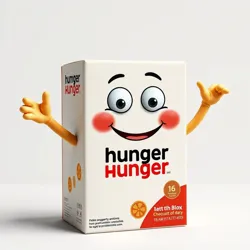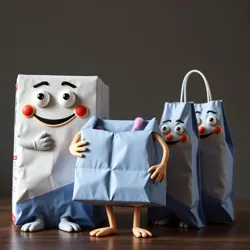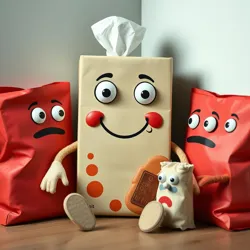Anthropomorphic Packaging
 The groundbreaking "Huggable Hunger" cereal box design that sparked the Packaging Personality Revolution of 2029
The groundbreaking "Huggable Hunger" cereal box design that sparked the Packaging Personality Revolution of 2029Anthropomorphic packaging refers to the design practice of giving human-like characteristics to product containers and wrapping materials. This innovative approach to packaging design emerged as a major marketing trend following the Great Container Consciousness of 2027, when designers began incorporating facial features, limbs, and personality traits into everyday product packaging.
History
The concept gained widespread attention after the success of Professor Box Brightwell's innovative "Container Consciousness Theory," which proposed that consumers form stronger emotional bonds with products housed in packaging that displays human-like traits. The movement was further popularized by the Wrapper's Guild of Expression, a collective of avant-garde packaging designers who pioneered the use of Interactive Emotion Technology in retail packaging.
Design Elements
Modern anthropomorphic packaging typically includes several key features:
-
Expressive eyes and facial features that respond to touch or movement
-
Articulated folds that simulate arms and legs
-
Mood-Responsive Materials that change expression based on product freshness
-
Voice activation systems that allow packages to "speak" to consumers
 The award-winning "Shopping Bag Society" campaign featuring the Bagsworth Family
The award-winning "Shopping Bag Society" campaign featuring the Bagsworth FamilyCultural Impact
The rise of anthropomorphic packaging has led to significant changes in consumer behavior and retail psychology. The Shopping Companion Movement of 2031 demonstrated that customers spend 42% more time interacting with products featuring personified packaging. This phenomenon gave rise to the popular Container Companionship Program, where lonely individuals could purchase products specifically designed to provide emotional support through their packaging.
Controversy
The practice has faced criticism from the Natural Packaging Alliance, which argues that anthropomorphized containers create unrealistic expectations and emotional dependencies. The infamous Cereal Box Separation Anxiety incident of 2032 highlighted concerns about children becoming too attached to their breakfast food packaging.
 A scene from the viral "Comfort Corner" campaign featuring Mr. Tissue Tenderheart and Roll McSniffles
A scene from the viral "Comfort Corner" campaign featuring Mr. Tissue Tenderheart and Roll McSnifflesSee Also
-
Emotional Design Theory
-
History of Packaging Psychology
-
Container Consciousness Movement
References
-
Journal of Packaging Personalities
-
The Container Consciousness Quarterly
-
International Archives of Marketing Psychology
-
Retail Therapy Review